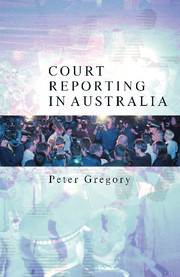Book contents
- Frontmatter
- Contents
- Figures and Tables
- Acknowledgments
- Introduction
- Chapter 1 The Court System: An Overview
- Chapter 2 Gaining Information
- Chapter 3 Contempt
- Chapter 4 Defamation
- Chapter 5 Writing the (Newspaper) Story
- Chapter 6 Subediting and Photography
- Chapter 7 Television and Radio
- Chapter 8 Human Relations and Ethics
- Chapter 9 An Atypical Friday at Court
- Chapter 10 Suppression Orders
- Chapter 11 Future Directions and Issues
- Bibliography
- Index
Chapter 11 - Future Directions and Issues
Published online by Cambridge University Press: 22 September 2009
- Frontmatter
- Contents
- Figures and Tables
- Acknowledgments
- Introduction
- Chapter 1 The Court System: An Overview
- Chapter 2 Gaining Information
- Chapter 3 Contempt
- Chapter 4 Defamation
- Chapter 5 Writing the (Newspaper) Story
- Chapter 6 Subediting and Photography
- Chapter 7 Television and Radio
- Chapter 8 Human Relations and Ethics
- Chapter 9 An Atypical Friday at Court
- Chapter 10 Suppression Orders
- Chapter 11 Future Directions and Issues
- Bibliography
- Index
Summary
Attend a conference or seminar about the future of law and journalism, and it's a fair bet the talk will turn to televising courts. Cameras have been allowed in various Australian courts, mainly broadcasts of judgments and sentencing decisions, footage taken at the start of proceedings, and ceremonial occasions. Writing in 1995, Justice Michael Kirby speculated on the inevitability of cameras in court. He mentioned the Bobbit and O. J. Simpson cases from the United States and described the controls needed to stop the unacceptable distractions of wandering camera operators, whose presence might affect the testimony of witnesses. Almost ten years later, camera access is regular, though still tightly controlled. Australian television has no station which markets live broadcasts of the most spectacular murder trials.
Access has changed in other ways. Tape-recorders are relatively common and journalists have good opportunities in many jurisdictions to see, if not copy, a range of documents, statements and photographs before the court. A favourite trick is to use excerpts from videotaped interviews with suspects once they have been convicted. Viewers (or readers seeing still shots) find another way to get closer to the courtroom. They are not getting special treatment – jurors will have seen the film in open court possibly weeks earlier. Television may make gains through stealth if its operators are allowed to broadcast that footage soon after it is played in court. The obvious objection is that television stations will use the most provocative images that make the accused look guilty.
- Type
- Chapter
- Information
- Court Reporting in Australia , pp. 173 - 179Publisher: Cambridge University PressPrint publication year: 2005



